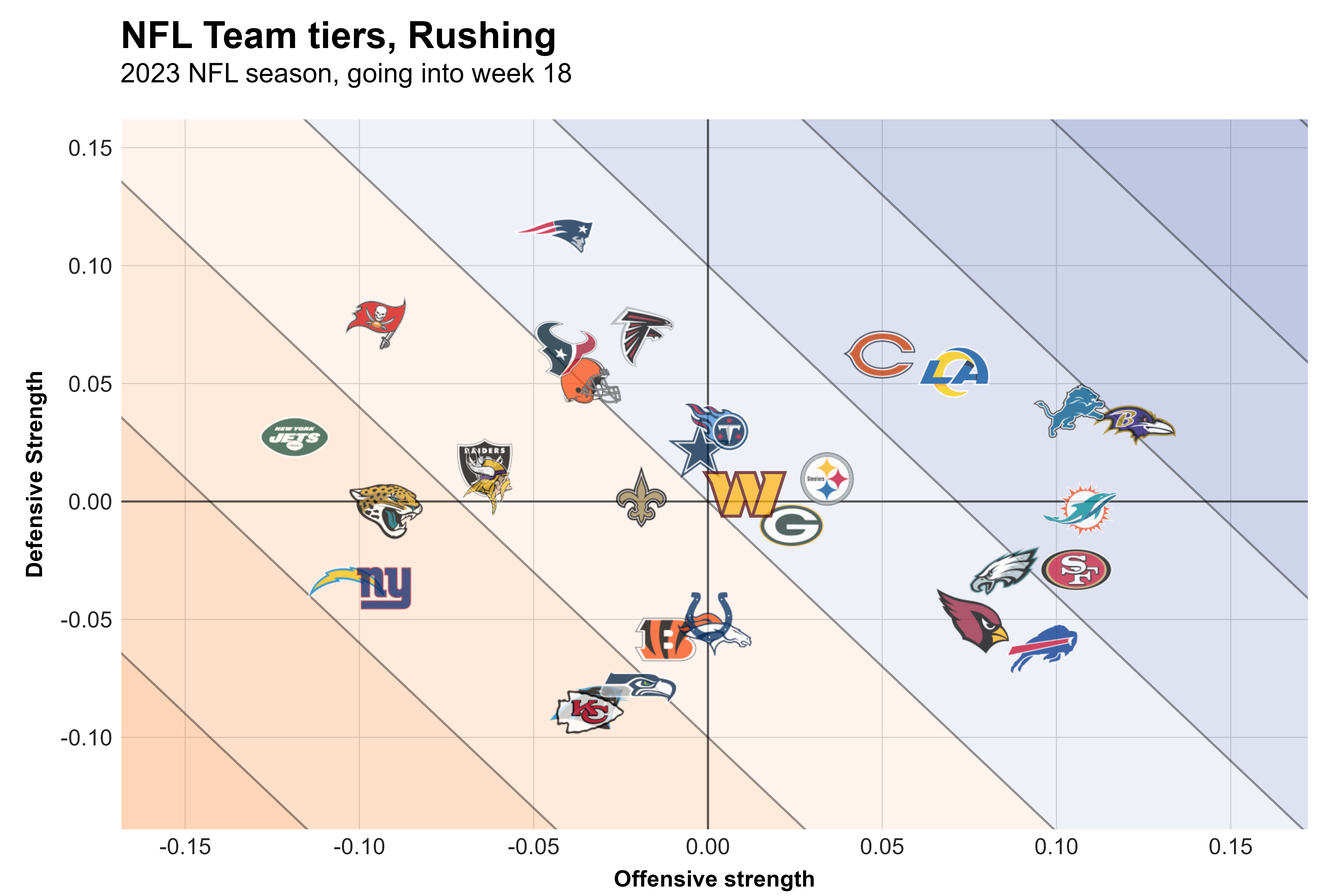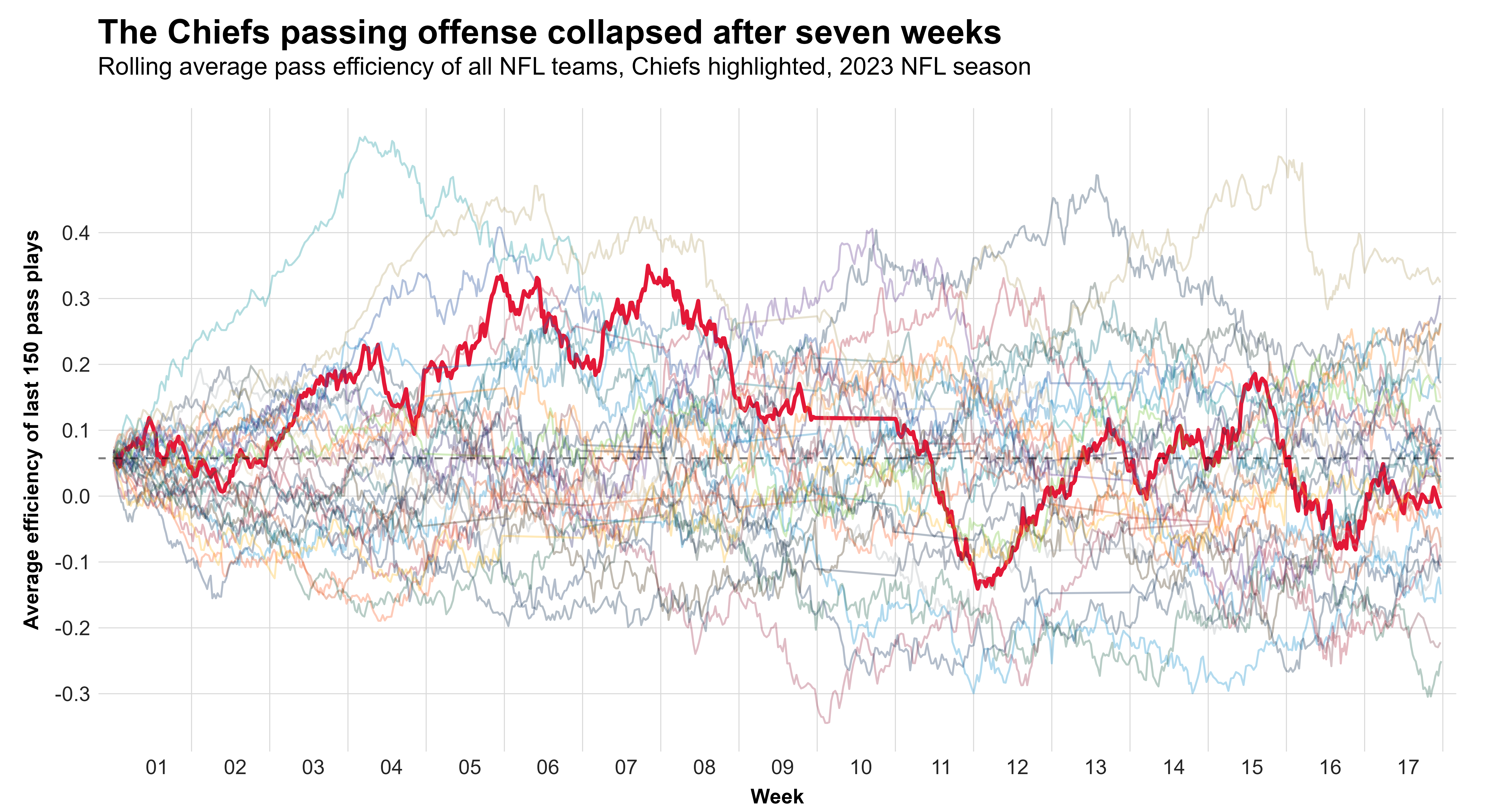• The midseason collapse: After the Chiefs' bye week, their passing game broke down. From Week 10 to Week 17, the team generated only 0.03 EPA per pass play, 17th in the league. Yes, the team with the best quarterback in the NFL ranked in the bottom half in passing efficiency during the second half of the season.
• The postseason resurgence: Mahomes and company averaged 0.14 EPA per pass play against the Ravens, not quite as good as their performances against the Dolphins (0.28) and Bills (0.38) but better than the 0.10 EPA per pass play they averaged over the regular season.
• Dig into the numbers for yourself: PFF's Premium Stats is the most in-depth collection of NFL and NCAA player performance data. Subscribe today to get full access!
This Sunday, the Kansas City Chiefs will make their fourth Super Bowl appearance in five years — only this time they'll be reigning champions.
But even though quarterback Patrick Mahomes is the overarching constant, it's safe to say that this year’s Chiefs team is different from the ones we've seen in past Super Bowls.
They are certainly not the same team they were in 2018 and 2019 when they were able to sprint down the field with a ridiculous amount of explosive plays but were always in danger of losing games — even when they scored more than 30 points.
They are also not the same team they were in 2022 when they not only found a way to overcome the loss of star receiver Tyreek Hill on offense but also capitalized on the resources acquired from the Hill trade to strengthen their defense. With the league's best offense and an above-average defense, the Chiefs were ultimately the best team in the AFC in 2022, and no one was surprised to see them take home another Lombardi Trophy after an all-time classic against the Philadelphia Eagles in Super Bowl 57.
The worst offense of the Mahomes era
This year, things went differently for the Chiefs.
Many of the bets they made to field a competitive wide receiving room post-Tyreek Hill did not pay off. Kadarius Toney, Marquez-Valdes Scantling and Skyy Moore made the Chiefs offense worse instead of helping it, with all three players earning sub-65.0 PFF receiving grades and averaging less than 1.20 yards per route run.
Travis Kelce also showed some signs of slowing down, as he averaged less than 2.00 yards per route run for the first time since 2021 — when he was still sharing the load with Tyreek Hill — and suffered from some uncharacteristic drop issues.
It didn’t help that the Chiefs also fielded a fairly bad running game.

The Chiefs offense simply made too many mistakes, and unlike in past years, they weren’t good enough to overcome them. This ultimately meant that the Chiefs fielded an offense that was much closer to mediocrity than to the best in the league.

While the above chart illustrates how far they were away from the top offenses in the league — notably the San Francisco 49ers — it also shows that they were still a fringe-top-10 offense.
Patrick Mahomes was the reason the offense was still better than the doomsday predictions might have suggested. The reasons the team was never in danger of losing the division was the play of their defense and the fact that the teams behind them were among the worst in football.
However, the worrying thing heading into the postseason was that Kansas City was even trending downward at the end of the regular season.
The collapse of the Chiefs passing game
The passing offense didn’t start the season as well as we have become accustomed to, but it still generated a respectable 0.17 expected points added (EPA) per play up until the Week 10 bye, tied fourth with the Philadelphia Eagles over that period. Only the San Francisco 49ers, Buffalo Bills and Miami Dolphins fielded a more efficient passing game up to this point.
After their bye week, things broke down. From Week 10 to Week 17 — we can exclude Week 18, when Mahomes got a much-needed rest — the Chiefs passing offense generated only 0.03 EPA per play, 17th in the league. Yes, the team with the best quarterback in the NFL ranked in the bottom half in passing efficiency during the second half of the season.
The following chart shows the Chiefs' passing efficiency throughout the season, and it turns out that the breakpoint can be pinned down to Week 8 more than the bye week.

A reemergence during the postseason
Given this trend, it was no surprise that the Chiefs were underdogs against the Baltimore Ravens and Buffalo Bills.
Entering the Super Bowl, the Chiefs defense has been playing lights out, having held the Miami Dolphins, Buffalo Bills and Baltimore Ravens to a combined 41 points. It has been playing so well that Steve Spagnuolo's group has not only gotten the well-deserved credit, but it has also done the unspeakable: It has made Patrick Mahomes and the Chiefs offense go almost unnoticed.
But the fact is that the Chiefs passing offense has enjoyed a renaissance over the last three games.

It’s notable that the Chiefs' postseason passing attack has been even better than the graph indicates, as the rolling average of the last 150 plays still includes plays from Week 18 when Mahomes didn’t play.
It’s also fair to note that we might remember the Chiefs offense as worse than it was because of recency bias around how the Ravens game ended. But, all things considered, the Chiefs averaged 0.14 EPA per pass play against the Ravens, not quite as good as their performances against the Dolphins (0.28) and Bills (0.38) but better than the 0.10 EPA per pass play they averaged over the regular season.
It also came against a Baltimore defense that allowed only -0.08 EPA per pass play up to that point, the second-best mark in the league behind only the Cleveland Browns.
The Chiefs also moved the sticks on 74% of their series against the Ravens, which aligns with their regular-season performance and is well above the league average and what the Ravens defense allowed throughout the season (66%).
The big question is, of course: Can the Chiefs keep that up for one more game? Let us take a deeper dive into what happened. First, let’s look at different metrics and how the Chiefs playoff run compares to the regular season.
| Weeks 1-17 | Rank | Postseason | Where would that rank? | |
| (weighted) EPA/play | 0.10 | 11th | 0.25 | 2nd |
| Success Rate | 49% | 7th | 53% | 2nd |
| EPA/play early downs | 0.08 | 13th | 0.27 | 2nd |
| EPA/play late downs | 0.16 | 9th | 0.17 | 7th |
| Net yards per pass play | 6.13 | 14th | 6.16 | 13th |
| Series conversion rate | 73.7% | 8th | 77.3% | 3rd |
They were better across the board, and the only reason they don't rank first in most metrics is because the San Francisco 49ers fielded a historically good offense over the regular season.
The only metric they didn’t improve is gaining yards on a play-by-play basis. The Chiefs haven’t become more explosive, but they’ve become more efficient and less prone to errors.
Usually, one would consider an offense that enjoyed a streak of high efficiency due to avoiding errors as more prone to regression, but the Chiefs have two factors going for them that have us believe that they can keep it going for one more game.
Andy Reid saves the good plays for the playoffs
My former colleague Eric Eager always says good teams hide their weaknesses in the regular season, while truly great teams use the regular season to work through them. The Chiefs seem to be a prime example of the latter.
During the regular season, we charted Patrick Mahomes throwing to his first or next read (i.e., in structure) on 67% of his dropbacks, well below the league average of 76%. The Chiefs gained 0.04 EPA per play on these throws, which ranked only 19th across the league. In other words, the structure hardly presented open options for Mahomes, and when it did, Kansas City didn’t produce efficient plays.
Things changed in the playoffs. The Chiefs don’t suddenly have open options running around on all plays, but PFF has charted Mahomes with throwing to his first or next read on 71% of his dropbacks in the postseason. More importantly, the Chiefs have been highly efficient, averaging 0.47 EPA per play on these throws.
Several factors may be behind this, such as Mahomes picking his spots more carefully and receivers avoiding drops in important situations, but it probably also points to better game planning and playcalling from the Chiefs' coaching staff. With two weeks to prepare for a San Francisco 49ers defense that has shown to be vulnerable this season, we would expect Andy Reid and his staff to come up with another good game plan.
We’ve seen Patrick Mahomes do that before
Better playcalling and fewer errors by Kansas City's receivers certainly help, but Mahomes has yet again taken his game to another level when it is most necessary.
As we’ve seen above, whenever the structure of the play allows it, he is making highly efficient throws. And when not, he is either scrambling for first downs or avoiding sacks while making insane throws during scramble drills.
And most importantly, he is not making any mistakes. No quarterback has taken more passing snaps than Mahomes this postseason, and yet he has zero turnover-worthy plays. For comparison, the 49ers' Brock Purdy could have been picked off three times against the Lions alone.
Mahomes already led the regular season with the lowest rate of negatively graded dropbacks (10.3%), but he is taking his mistake avoidance to another level in the playoffs, as PFF has graded him negatively on only 6.3% of his 127 postseason dropbacks.
There were only two streaks of consecutive games with at least 120 dropbacks and such a low rate of negatively graded dropbacks in PFF's database in 2023, and it’s pretty good company:
| Weeks | Negatively Graded Play Rate | Dropbacks | |
| Josh Allen | 2-5 | 5.7% | 159 |
| Justin Herbert | 11-13 | 4.4% | 136 |
Mahomes himself had a similar streak earlier this season, earning a negative grade on 6.9% of his 188 dropbacks from Weeks 5 to 8, but the difference was that he was graded positively on “only” 23.4% of plays during this stretch, a huge difference to his postseason streak, as we will see later.
Mahomes’ error-free play is also reflected in the outcomes of his dropbacks. The following chart shows how different dropback outcomes contributed to the overall efficiency of the Chiefs' passing offense. The biggest uptick compared to the regular season comes from avoiding sacks and turnovers.
| Contribution From | Regular-Season EPA | Rank | Postseason EPA | Where Would This Rank? |
| Targets (excl. INT) | 0.26 | 15th | 0.28 | 11th |
| Scrambles | 0.05 | 3rd | 0.05 | 3rd |
| Sacks | -0.07 | 2nd | -0.02 | 1st |
| Interceptions | -0.10 | 22nd | 0.00 | 1st |
| Throwaways/Batted Passes | -0.07 | 25th | -0.06 | 22nd |
Nearly flawless play on a small sample would usually cause one to pause and assume inevitable regression, but we’ve seen Mahomes do it before when he became the only quarterback since 2006 to finish a Super Bowl without a single negatively graded dropback last year against the Philadelphia Eagles.
The Chiefs' offense is not what it once was, and we shouldn’t expect them to beat the 49ers' defense with a high number of explosive plays. Stringing together enough first downs for a touchdown drive has often looked like a challenge for them this year. However, during the playoffs, the Chiefs' offense has presented more solutions for Mahomes in structure, as also evidenced by his 29.1% rate of positively graded plays in the postseason compared to 23.7% in the regular season.
With positively graded plays being more opportunity-based than the avoidance of negatively graded plays, this once again suggests how Andy Reid and top target Travis Kelce have dialed it up in the postseason. Pair this with Mahomes' mistake-free play, and you get a Chiefs offense whose success in recent weeks is probably more than just a fluke. It isn't a foregone conclusion that they'll once again avoid crucial mistakes, such as a drop beyond the sticks or even a passing misfire, but they are certainly in a much better position to overcome the occasional mistakes than we thought they were four weeks ago.
Whether that’s enough to become the first Super Bowl repeat winner since the 2004 Patriots remains to be seen. After all, the 49ers themselves have one of the most potent offenses we’ve ever seen, and while they were in somewhat of a crisis for four out of their eight postseason quarters, they have still generated more EPA per play than the Chiefs in the postseason, mostly due to more explosive plays and a more consistent rushing attack.
This means that when it’s all said and done, the Chiefs — who seem to be closing as a Super Bowl underdog for the second consecutive year — might need both to come away victorious: the continuation of their offensive trend plus another masterclass from coordinator Steve Spagnuolo and the defense.




 © 2025 PFF - all rights reserved.
© 2025 PFF - all rights reserved.